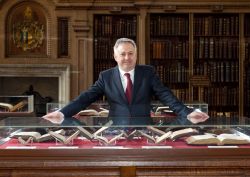Sussex professor curates exhibition on the people’s prayer book
The Book of Common Prayer is the subject of a new exhibition that celebrates the Queen’s Diamond Jubilee and the revised version’s 350th anniversary, co-curated by Professor of English Brian Cummings at Lambeth Palace in London.
 The exhibition takes place in the magnificent surroundings of the 17th-century Great Hall of the Palace, traditionally the London residence of the Archbishop of Canterbury, and was opened on Tuesday (1 May) by HRH the Prince of Wales, who has taken a personal interest in the exhibition.
The exhibition takes place in the magnificent surroundings of the 17th-century Great Hall of the Palace, traditionally the London residence of the Archbishop of Canterbury, and was opened on Tuesday (1 May) by HRH the Prince of Wales, who has taken a personal interest in the exhibition.
The Church of England’s Book of Common Prayer, regarded as the most listened to book in English history, contains phrases that remain part of the English language and Anglican ritual around the world to this day.
But the book’s entire history – its introduction, banning, burning and numerous revisions – is also bound up in the sometimes controversial and violent politics of English religion and royalty over the past five centuries.
The exhibition incorporates some fascinating exhibits, some never seen before, including:
- a Book of Hours owned by the doomed Richard III;
- Henry VIII’s angry crossings out and notes in a book presenting Catherine of Aragon’s case against their divorce;
- Elizabeth I’s personal prayer book and her authorisation of the execution of her Catholic cousin, Mary Queen of Scots;
- the gauntlet gloves worn by the “martyr” King Charles I on the scaffold, complete with golden sequins.
The exhibition follows 10 years of research by Professor Cummings for his recently published The Book of Common Prayer: The Texts of 1549, 1559 and 1662 – named by the present Archbishop of Canterbury as a Book of the Year in the Times Literary Supplement.
Professor Cummings says: “The Book of Common Prayer is a work that has had an enormous impact – it’s more like a character in history than an object.
“Loved and reviled in equal measure it evoked passion and violence, and serves today as a repository of English language and religious observance during dangerous times.
“We’ve tried to give voice not only to the champions of the book here, but also to the dissenting voices of Catholics and Puritans. This exhibition is as much their story as it is that of the Establishment and the monarchy.”
Professor Cummings was assisted in his work on the exhibition, which runs until 14 July, by doctoral student Katharine Fletcher, who helped to prepare the exhibit cabinets and display captions.
